Penetrator
| ACA Penetrator series | |
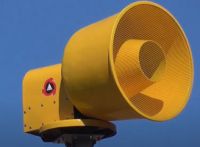 A freshly refurbished ACA P-10, located in Upson County, GA. Image credit to TrainsandSirens1. | |
| Company | |
|---|---|
| Produced | 1980-2007 |
| Type | Rotational Electromechanical |
| Sound output | 125-135 dB @ 100 ft |
| Frequency | 60 Hz |
| Horsepower | 10-50 hp |
| Voltage | 208-230/460 V AC 1 or 3 ph |
| Preceded by | |
| Succeeded by | ASC Tempest |
The Penetrator is a series of rotational electromechanical sirens that was produced by Alerting Communicators of America that mainly consisted of 4 models: The P-10, P-15, PN-20, and the P-50. The Penetrator series proved to be one of ACA's most popular sirens throughout the 1980s for their reliability and output, and many can still be found in service today.
Models
Penetrator-10
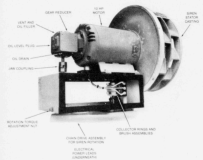
The Penetrator-10 (also named the P-10) was the first model to appear in 1980 and was designed as the successor of the Allertor 125 to perfect the design faults the Allertor had, such as ice buildup in the projector drum. It took the horn and intake cone from the ACA Howler and enlarged and redesigned them to fit the Allertor's proportions and would be sold alongside the Howler. It uses a dual-sided Doerr (later Baldor) 10 hp AC motor to drive both the chopper and the rotator at once and comes in both 8-port single tone and 9/12-port dual tone. However, the 9/12 dual tone was much more common on the P-10 due to the extra strain the heavier 8-port rotor put on the motor. It was available in either single or 3 ph power.
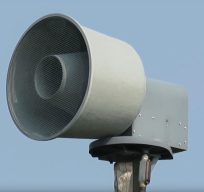
The P-10 uses a chain-driven rotator, which is located underneath the siren. The siren's motor is coupled to a gear reduction drive that drives a shaft vertically through the siren towards the bottom, where it rotates a gear against the chain to rotate the entire siren unit on a stationary base. The chain itself is covered on top with a teardrop-shaped cover to protect it from the elements and is the same rotator that the 3rd generation Allertor uses. The rotator was also reused on early ACA Alertronic AL-6000R units, facing backward. Due to the intake and projector being placed together, the siren's overall sound output is slightly lower than the Allertor, which has the intake and projector separate. As a result, the P-10 is only able to achieve 125 dB at 100 ft, 1 decibel shy of the Allertor.
However, the projector's benefits, such as ease of maintenance and resistance to ice more than make up for the performance loss. It can be difficult to tell a P-10 and a P-15 apart without seeing the tag, as single-tone units will have cylindrical intakes, while dual tones will have conical intakes and thus cannot reliably be used to tell them apart despite popular misconception. The best way to tell them apart is the windup speed, as the P-10 will often wind up a bit slower. This is not always reliable, however, as 1 ph units of both models may struggle to reach full pitch with worn run capacitors. The conical intakes on dual-tone units are prone to collapsing, due to the bolts rusting out. With dual-tone sirens being seen as no longer necessary after the Cold War ended, the P-10 was discontinued when ACA went bankrupt in 1992 and was not carried over during ACA's transition to ASC. It was likely decided that it was no longer worth producing both sirens when the P-15 handled the single tone rotor better.
Penetrator-15
P-15
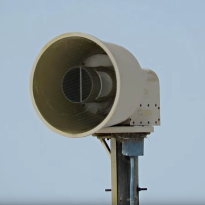
The Penetrator-15 (also known as the P-15) was introduced in 1981 and is nearly identical to its older brother, but is instead powered by a dual-sided Doerr (later Baldor) 15 hp AC motor, in either single or 3 ph. Other than motor horsepower, the P-15 is identical to the P-10, using the same core and body. The P-15 was available in both 8-port single-tone and 9/12-port dual-tone, and boasted a rating of 127 dB at 100 ft. The P-15 is most commonly found with the 8-port single-tone rotor, as the motor is much more capable of handling it and its higher performance made single tone a more attractive option.
A three-signal P-15 was available, which utilizes a solenoid-operated damper inside of the cylindrical intake, which would allow the siren to create pulse signals. The solenoid mechanism is housed in a rounded cover on the side of the intake. There was also a two-signal model that used a valve held closed by a spring. The valve would be forced open by the intake of air when the siren began operating, and when the siren shuts off, the spring overpowers the airflow and forces the valve back closed making the winddown much less audible. This was likely meant for urban use, silencing the siren quickly without using a brake or solenoid. It may have also been used as a weatherproofing measure. Three-signal units are very uncommon, with most active surviving units being in the Memphis, TN area, though none of them use their dampers.
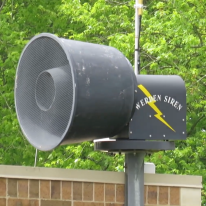
RM-127
In 1992, the P-15 was re-released as the PN-15 and soon after the RM-127, following ACA's reformation into the American Signal Corporation by HÖRMANN in 1994. The 9/12-port dual-tone option was dropped in favor of making the RM-127 exclusively 8-port single-tone, as the need for dual-tone sirens had ended with the end of the Cold War. The RM-127 would continue to be produced until 2002 when it was replaced by the ASC Tempest-128.
Werden P-127
After the RM-127 was discontinued in 2002, ASC sold the patents of the RM-127 and the Banshee 115 to the Ohio-based company Werden Electric, who built and installed their own variant of the single tone P-15, called the P-127. The P-127 is nearly identical in appearance and performance to a standard P-15/RM-127, sporting Werden's logo and paint job. Some units make use of a conical intake in the style of dual tone Penetrators, while others use a cylindrical intake. The P-127 was only produced in 8-port single tone, with no dual-tone units having been produced. Due to Clayton Werden's retirement, it is unlikely that more of these sirens will be produced.
Penetrator-20
PN-20
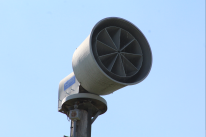
The Penetrator-20 (also known as the PN-20) began as an experiment by ACA in 1988 to create a "Performance Plus" fully DC siren using the Penetrator platform, with the ultimate result being the PN-20. The PN-20 uses the Screamer S-7.5's 9-port single tone rotor. Using 9 throats around the stator ports (similar to a Federal Signal 2001), the PN-20 boasted a 130 dB at 100 ft rating by forcing all of its output through 9 horns attached to the front of the stator throats, with the outer projector projecting the sound emitted from the intake. The PN-20 used a dual-sided 7.5 hp 240 V AC motor, which was hooked up to a DC-to-AC converter that ran the siren on 25 large DC batteries stored under the controller. This would prove to be expensive and impractical, and few PN-20 units were sold compared to the other Penetrator models.
The chain-driven rotator mechanism and motor cover are reused from the Penetrator-10 and 15 and are largely interchangeable. Most of these early PN-20 units were installed in Eden Prairie, MN alongside some P-15 prototypes, and few were made before the siren was redesigned. In 1992, the siren was re-released with some of its major flaws corrected. The 7.5 hp AC motor was replaced by a 20 hp 72 V DC motor, and the AC converter was removed. This allowed the siren to run on fewer batteries and made the siren overall more efficient, which drove down costs and maintenance requirements. ACA also experimented with a 96 V DC variant of this siren, which was otherwise completely identical to the 72 V DC version. This proved to be a failure due to excessive arcing in the motor, and this variant of the siren was not put into production.
RM-130
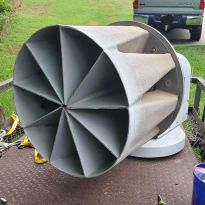
When ACA became the American Signal Corporation under HÖRMANN's ownership in 1994, the siren would be renamed to the RM-130. Other than the decals and paint, the siren was entirely identical to the redesigned 72 V DC PN-20. The siren would remain unchanged for most of its lifespan, though in the late 1990s, the gearing on the rotator was changed to rotate at 2 rpm instead of 3.5 rpm. This change was done near the end of the siren's production, and as of 2022 all of these 2 rpm units have been removed. The RM-130 was eventually discontinued, along with the RM-127, in 2002 as it was directly replaced by the ASC Tempest-128 which solved a lot of the RM-130's flaws. Several PN-20 and RM-130 units are still in service today, but many have been replaced with newer sirens due to their age. ACA also experimented with other "Performance Plus" Penetrator designs, including replacing the P-15's rotator with an Alertronic's rotator and using a DC motor, but the 8-port rotor proved to be far too heavy for the motor and batteries to handle, leading to the batteries rapidly draining and the siren losing pitch quickly when operating. This short-lived design would be later replaced by the PN-20. An example of a PP-15 used to be in service in Eden Prairie, MN, but has since been removed leaving none left in existence.
Penetrator-25
The Penetrator-25 (also known as the P-25) was a siren that was intended to be produced by ACA in the 1980s, though it never made it into production. According to Jim Biersach himself, two prototypes were built, both using a 21" 9-port single-tone rotor and stator, driven by a 25 hp AC motor, which was taken from the SuperBanshee 115 with one of the shafts cut off. One unit was 1 ph, while the other was 3 ph. The siren was intended to bridge the gap between the P-15 and P-50, with performance likely landing somewhere in between. It used the same horn as the P-15, and likely sported a unique design requiring the use of a separate motor to drive the rotation mechanism, similar to a rotational Alertronic. Unfortunately, the siren never made it to production, as when the prototypes were completed and the siren was ready to be produced, it was discovered that the aluminum foundry they contracted for the $200K rotor and stator casting patterns had gone bankrupt, and the landlord had thrown out the casting patterns along with everything else. ACA could not justify spending another $200K to make new casting patterns for such a niche siren and knew it would never make a profit, and it thus was never produced. The whereabouts of the two prototypes are currently unknown but are presumed scrapped.
Penetrator-50
P-50
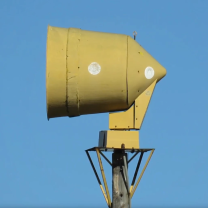
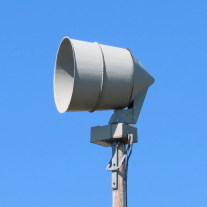
The Penetrator-50 (also known as the P-50) was introduced into ACA's lineup in 1980 as a replacement for the Hurricane 130 MKII, boasting incredible sound output without the need for a blower, which means the siren also requires less maintenance. The P-50 is unlike its brothers in that the P-50 shares a rotor and stator with the ACA Cyclone 120 and is essentially a Cyclone 120 flipped on its side with a rotator and projector attached. This meant the siren was exclusively 8/12-port dual tone and allowed the siren to reach a staggering 135 dB at 100 ft, and to this day remains the loudest electromechanical siren ever made, only being beaten in sound output by the gas-driven Chrysler Air Raid Siren. The rotor is 24 1/16 inches in diameter, one of the largest rotors used on a siren. The siren runs on a large 50 hp AC motor, which was only available in 3 ph at 208-230 or 460 V. The P-50 is an incredibly large siren and was advertised as being big enough for an adult man to stand inside the horn without having to crouch. An eyebolt is attached to the rear housing on all P-50 units.
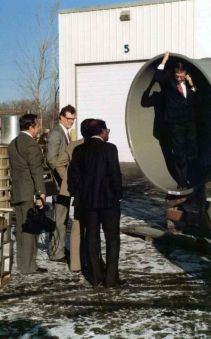
A large mesh screen installed within the horn protects the siren from debris, which is mounted in the exact middle of the horn on later units and near the front of the siren on the oldest units. The siren is rotated at 3 rpm by a chain-driven rotator below the siren, which is contained inside a uniquely shaped housing that has enough clearance for the stand that connects the rotator shaft to the rest of the siren. One thing of note is that depending on the controller used, the P-50 will immediately stop rotating upon the chopper being unpowered, as it is not driven by the chopper motor and cannot coast. The siren uses a large, slightly flared cylindrical fiberglass projector that focuses all of the output in a single direction and uses a two-piece projector.
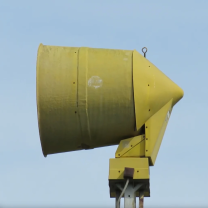
The earliest units used a different projector design, which had a flat, wider ring around the horn where the inner mesh screen and the outer horn section were bolted. The front horn section was originally much smaller, with the two pieces being bolted near the front of the projector, though this was later changed to using two sections of equal length, bolted in the middle. Most P-50s produced afterward use a large ring in between the two sections where they are bolted together. Most of these early P-50s were painted yellow, while later units were typically painted gray.
RM-135/T-135AC
The P-50 was reintroduced as the RM-135 in 1994, when ACA was reformed into ASC by Hörmann, becoming the loudest siren in the RM series of sirens. The RM-135 was identical in design to the P-50, however, ASC's controller allowed the siren to continue rotating after the chopper shuts off, which made its attack signal more effective. When ASC was sold by HÖRMANN to Dale Moeller in 1998, the RM-135 would be incorporated into the new Tempest series of sirens as the Tempest-135AC. The T-135AC would ultimately be discontinued when the T-128's larger variant, the T-135AC/DC, was introduced in 2007. While the T-135AC/DC is not as loud as the T-135AC, it is battery backup capable and runs on DC power which made it more reliable in an emergency, and used far less power than the T-135AC which made it easier to install and operate.